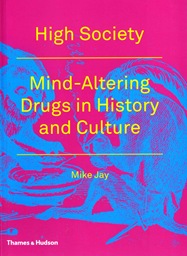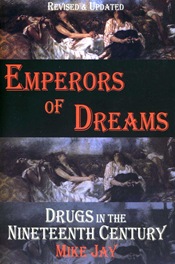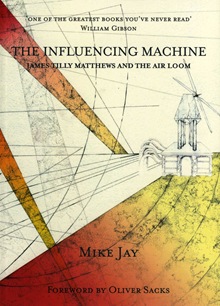

There is a huge literature on the history of drugs yet little of this knowledge has permeated into the mainstream drug debate, which remains locked into emotional polarised discussions between prohibitionists and libertarians, between those who believe in criminalising drug users and those who believe that addictions should be treated as a medical issue. All parties would benefit greatly from reading these two books by Mike Jay.
Mike Jay is an author and historian who has written widely on the history of science and medicine, and is a specialist in the study of drugs in all cultures through time.
‘High Society: Mind-Altering Drugs in History and Culture’, just published in paperback by Thames & Hudson, was originally produced to tie-in with an exhibition at London’s Welcome Collection (11 Nov 2010 – 17 Feb 2011), co-curated by Mike Jay working with Caroline Fisher and Emily Sargent. from the Wellcome - whose library on the history of medicine is world-class.
The book divides into three man sections: A Universal Impulse, From Apothecary to Laboratory and The Drugs Trade. It is heavily illustrated with some remarkable objects and images from the Wellcome Collection.
Section One begins with a short sun-up to sundown tour across the globe, establishing that drug taking is an established part of every society in our modern world. This has always been so. One of the ‘human universals’ identified by anthropologist Donald E. Brown is the use of ‘mood or consciousness altering drugs’. The oldest evidence of human drug paraphernalia is two chillum pipes that were discovered in 1973 in the Andes of N.W. Argentina dating from before 2000BC. The pipes contained a burnt residue of a mountain shrub that is a rich source of DMT – a powerful natural hallucinogen.
In Section Two we learn that ‘drug’ as a concept emerged with written history, the first mention being in the the oldest medical Egyptian text dating from 1600 BC. Later came Dioscorides (c.40-90AD) whose five-volume De Materia Medica became a standard text for the next 1500 years. The volume of medicinal roots and herbs carried, says Jay, ‘the first description of many drugs with psychoactive effects loosely grouped together.’
The world ‘drug’ apparently came into common usage around AD 1400 and was probably derived from the Dutch term for ‘dried goods’. The apothecaries of medieval Europe were the first to understand that drugs might be isolated as ‘pure’ substances from the plants that contained them. Paracelsus (1493-1521) pioneered the distillation and refinement of these substances in more potent forms.
The first such preparation to achieve widespread usage was laudanum, popularised by the 17thC physician Thomas Sydenham. His recipe: 2ozs of opium in a pint of strong red wine or port, spiced with saffron, cloves and cinnamon. One of his apprentices Thomas Dover later produced the first off-the-shelf version: Dover’s Powder which consisted of opium mixed with liquorice and ipecacuana, a South American emetic. This preparation remained on sale until the 1930s.
In the 18th century came the first drug not derived from plants – nitrous oxide (‘laughing gas’). Its effects were first explored at the Pneumatic Institute in Bristol where scientists and poets, including Southey and Coleridge, enjoyed its effects and developed a new ‘language of feeling’.
In 1817 Friedrich Serturner isolated morphine from an extract of opium concentrate and transformed chemistry, especially in Germany, into an industrial science supplying plant-derived compounds for a vast new pharmaceutical market. Caffeine was isolated from coffee in 1820, nicotine from tobacco in 1823 and cocaine from the coca leaf in 1860.
De Qunicey’s ‘Confessions of an English Opium Eater’, first published as a serial in 1821, marked, says Jay, ‘the arrival in popular culture of drugs as agents of pleasure and fascination.’ This image of a drug user ‘would shape public perceptions for the rest of the century and beyond.’
By the end of the 19th century, pharmacies were like sweet shops. The modern stigma of drugs was yet to emerge and medicines containing opiates, cocaine and cannabis were freely available.
In the 20th century the term ‘drug’ acquired its modern meaning and terms like the ‘drug menace’ and ‘junkie’ entered common parlance. Widespread legislation and prohibitions came into effect and there developed a clear division between substances used for medicine and those used for recreational purposes – a distinction Jay believes ‘cannot be permanent’.
As for the future, Jay writes: ‘Some commentators claim that we are on the brink of a future posthuman condition where brains are chemically tuned to their optimum level of performance, all anxiety and dysfunction is medicated away and heightened consciousness becomes a permanent, even universal state.’
Section Three on the history of the drug trade is equally informative and enlightening. The Golden Ages of Discovery brought a range of new substances to the attention of Western nations – including tobacco, coffee, cocoa and tea – giving birth to the global drug trade and the ‘psychoactive revolution’. The Opium Wars led to widespread prohibitions, all of which have failed to stem a rising tide of global drug usage.
Jay concludes: ‘Today’s illicit drugs trade, estimated by the UN at $320 billon USD a year, now constitutes one of the largest international markets on the planet, along with arms and oil. Whether it remains prohibited, or is regulated and taxed, it will continue to drive the global economy of the future.’
‘Emperors of Dreams: Drugs in the Nineteenth Century’ [2011. Daedalus Books] is a revised and updated version of a book originally published in 2000. It contains seven essays on the 19thC discovery and use of the following substances: Nitrous Oxide, Opium, Cannabis, Ether & Chloroform, Cocaine, Mushrooms & Mescaline, and Alcohol.
Jay writes: ‘During the nineteenth century drugs were hailed by scientists as the crowning glory of the modern age, and praised by artists and philosophers as the keys to transcendental realms beyond religion; promoted by doctors as the solution to the crises of modern life and demonised by politicians as the agents of sinister conspiracies against civilisation itself.’
Taken together, these two valuable books will completely change your perspective on drugs and their history.
For completists, Jay has also published 'Artificial Paradises: A drugs reader' (1999) and 'The Atmosphere of Heaven' (2009), a book-length study on the Pneumatic Institute. His website also contains some great essays including ‘Watson – The Needle: Sherlock Holmes and Cocaine’ and ‘Opium and the Symphonie Fantastique’

In addition, this is his latest book, just produced by the excellent indie publisher Strange Attractor.
By way of recommendation it comes with an intro by Oliver Sachs and a great one-liner from William Gibson: ‘One of the greatest books you’ve never read’.
It concerns the life of an obscure figure named James Tilly Matthews whose story has long been a strange landmark in psychiatric history but one that has never been told for a general audience.
The book plunges us into the time of the French Revolution when turmoil raged. Matthews has been committed to Bedlam as an incurable lunatic, after yelling out the word ‘TREASON’ at the then Houses of Parliament. He was to remain in this crumbling ruin for virtually the whole of his life.
His case is taken up by Bedlam’s resident apothecary John Haslam who will devote the rest of his professional life to Matthews, an obsession that ruined him. Determined to convince him of his madness, he treated Matthews with great cruelty but was undone by his patient’s resilience and strength of character. He was no ordinary lunatic and, in fact, was to become a star patient on the strength of his imaginings.
Matthews had two very strange stories to tell. The first was that he had been employed on an undercover mission to try and broker a peace deal between Britain and Revolutionary France.
Secondly, that all the unfolding events of this turbulent time were being generated by a strange machine, the pneumatic Air Loom – controlled by a very creepy gang of seven led by Bill The King – who were weaving their ‘magnetic webs around the corridors of power’
Matthews life-story survived as an urban legend and in psychiatric history but, says Jay, ‘the great survivor of the story in undoubtedly the Air Loom.
In Matthews’ time, ‘the notion of human minds being covertly controlled by machines was an outlandishly novel concept… Today…the notion barely even requires explanation: it is familiar to every twelve-year old who has read comics, watched The X-Files or The Matrix.’
Its hard to praise this book too highly. Intensively researched, Jay tells this incredibly complex story in such a captivating way that he outdoes Umberto Eco. The vividness of Matthews’ visions are evenly matched by Jay’s powerful evocations of the inside of Bedlam and the insanity of the Revolution. It will haunt your imagination as it has mine.
No comments:
Post a Comment